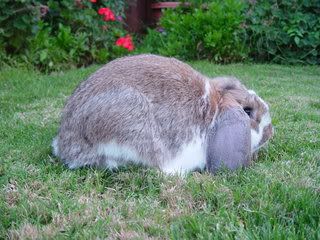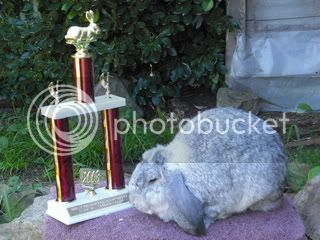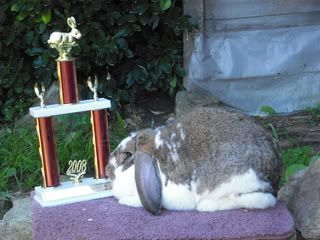bunnylover78642
Well-Known Member
[align=center]French Lop[/align]
[align=center]

[/align]
[align=center]
History[/align]
[align=center]The French Lop Rabbit was first bred in France around 1850 and was established in France as a rabbit for meat during the mid 1800s. Produced by crossing two existing breeds, the English Lop and the Butterfly Rabbit of France. The Butterfly rabbit is still bred in France and can be seen at the Grand Prix Show in Paris, this rabbit closely resembles our Flemish Giant of today, but is shorter in body and weighs approximately 15 pounds. French Lop Rabbits were imported into the USAin 1970-1971.
[/align]
[align=center]
Appearance
The French Lop is a very large rabbit, weighing more than 10lb (4.5kg) with lop ears of between 5 to 8cm long that hang down below the jaw, and an almost cubic appearance with a short thickset body and large head. The front legs are short and straight and the hind legs are carried parallel to the body. The French Lop has a dense, soft coat that
comes in two color varieties: solid and broken, and within these categories can be found a number of different rabbit colors, including agouti, black, broken marked, chinchilla and sooty-fawn.
Sr. Bucks - 8 months of age and over, weight 10 1/2 lbs. and over
Sr. Does - 8 months of age and over, weight 11 lbs and over
Int. Bucks - 6-8 months of age, not over 11 1/2 lbs
Int. Does - 6-8 months of age, not over 12 lbs.
Jr. Bucks and Does - under 6 months of age, not over 10 1/2 lbs, Min weight 5 1/4 lbs.
Groups: Agouti, broken, self, shaded, ticked, wide band
Classifications: broken pattern, solid pattern
[/align]
[align=center]
Breeding
The ideal age for the female French Lop rabbit to startbreedingis 9 months of age, but the first litter must be born before the female is one year old, due to the fusing of the pelvic bones that would hinder her ability to give birth naturally. It is recommended that they should not have any more litters after the age of three years. The French Lop rabbit can produce large litters, usually between 5-12 with a gestation period of between 28â31 days. On average they give birth at 30â32 days.[/align]
[align=center]
Behavior
Due to their relatively larger size in comparison to other breeds, the French Lop may require a large hutch/run to move around freely. They are known to have a placid and relaxed temperament, and can tolerate other species. However, they are considered as unsuitable in the presence of small children due to a risk of injury, and for people that have limited space, although they can live in the house as a house pet. As a social animal, it is recommended that a French lop rabbit be housed with a companion, that may include a fellow rabbit, although there is currently a debate on the suitability of the pairing of a French Lop and a smaller animal.
[/align]
[align=center]
Lifestyle
A French Lop is able to live outside and inside, a water-proof hutch that shelters the rabbit from any rain, snow, or heat is acceptable. If inside, a hutch or a cage can be used. If you are not giving your Lop regular time to spend with, consider getting two rabbits, a lonely rabbit that does not get regular exercise or companionship can be anti-social and depressed.
[/align]
[align=center]
Diet
Like the majority of rabbits, the most important component of the diet of a French Lop rabbit is hay, roviding indigestible fiber necessary to keep the gut moving. Grass hays such as timothy are generally preferred over legume hays like clover and alfalfa. Legume hays are higher in protein, Calories, and calcium, which in excess can cause kidney stones and loose stool. This type of hay should be reserved for young kits or lactating does.
It is recommended that the French Lop, like other rabbits, receive a standard intake of 2 cups of chopped dark, green, leafy vegetables per 6 pounds of body weight.and up to 2 tablespoons of fruitsorCarrots per 6 pounds of body weight daily. It is common for some owners to provide treats, although in very limited quantities, which can include a few pellets, a slice of strawberry, or other healthy foods. Commercial treats are available in the pet stores in shops and can be occasionally used, although even more sparingly, since they typically feature a higher sugar and starch content.
[/align]
[align=center]

[/align]
[align=center]
History[/align]
[align=center]The French Lop Rabbit was first bred in France around 1850 and was established in France as a rabbit for meat during the mid 1800s. Produced by crossing two existing breeds, the English Lop and the Butterfly Rabbit of France. The Butterfly rabbit is still bred in France and can be seen at the Grand Prix Show in Paris, this rabbit closely resembles our Flemish Giant of today, but is shorter in body and weighs approximately 15 pounds. French Lop Rabbits were imported into the USAin 1970-1971.
[/align]
[align=center]
Appearance
The French Lop is a very large rabbit, weighing more than 10lb (4.5kg) with lop ears of between 5 to 8cm long that hang down below the jaw, and an almost cubic appearance with a short thickset body and large head. The front legs are short and straight and the hind legs are carried parallel to the body. The French Lop has a dense, soft coat that
comes in two color varieties: solid and broken, and within these categories can be found a number of different rabbit colors, including agouti, black, broken marked, chinchilla and sooty-fawn.
Sr. Bucks - 8 months of age and over, weight 10 1/2 lbs. and over
Sr. Does - 8 months of age and over, weight 11 lbs and over
Int. Bucks - 6-8 months of age, not over 11 1/2 lbs
Int. Does - 6-8 months of age, not over 12 lbs.
Jr. Bucks and Does - under 6 months of age, not over 10 1/2 lbs, Min weight 5 1/4 lbs.
Groups: Agouti, broken, self, shaded, ticked, wide band
Classifications: broken pattern, solid pattern
[/align]
[align=center]
Breeding
The ideal age for the female French Lop rabbit to startbreedingis 9 months of age, but the first litter must be born before the female is one year old, due to the fusing of the pelvic bones that would hinder her ability to give birth naturally. It is recommended that they should not have any more litters after the age of three years. The French Lop rabbit can produce large litters, usually between 5-12 with a gestation period of between 28â31 days. On average they give birth at 30â32 days.[/align]
[align=center]
Behavior
Due to their relatively larger size in comparison to other breeds, the French Lop may require a large hutch/run to move around freely. They are known to have a placid and relaxed temperament, and can tolerate other species. However, they are considered as unsuitable in the presence of small children due to a risk of injury, and for people that have limited space, although they can live in the house as a house pet. As a social animal, it is recommended that a French lop rabbit be housed with a companion, that may include a fellow rabbit, although there is currently a debate on the suitability of the pairing of a French Lop and a smaller animal.
[/align]
[align=center]
Lifestyle
A French Lop is able to live outside and inside, a water-proof hutch that shelters the rabbit from any rain, snow, or heat is acceptable. If inside, a hutch or a cage can be used. If you are not giving your Lop regular time to spend with, consider getting two rabbits, a lonely rabbit that does not get regular exercise or companionship can be anti-social and depressed.
[/align]
[align=center]
Diet
Like the majority of rabbits, the most important component of the diet of a French Lop rabbit is hay, roviding indigestible fiber necessary to keep the gut moving. Grass hays such as timothy are generally preferred over legume hays like clover and alfalfa. Legume hays are higher in protein, Calories, and calcium, which in excess can cause kidney stones and loose stool. This type of hay should be reserved for young kits or lactating does.
It is recommended that the French Lop, like other rabbits, receive a standard intake of 2 cups of chopped dark, green, leafy vegetables per 6 pounds of body weight.and up to 2 tablespoons of fruitsorCarrots per 6 pounds of body weight daily. It is common for some owners to provide treats, although in very limited quantities, which can include a few pellets, a slice of strawberry, or other healthy foods. Commercial treats are available in the pet stores in shops and can be occasionally used, although even more sparingly, since they typically feature a higher sugar and starch content.
[/align]






